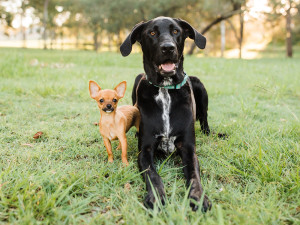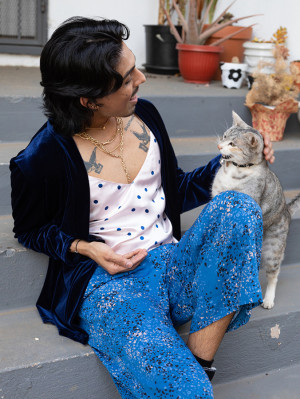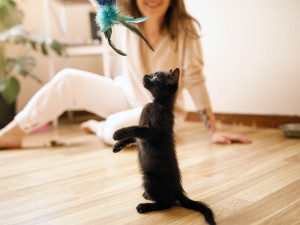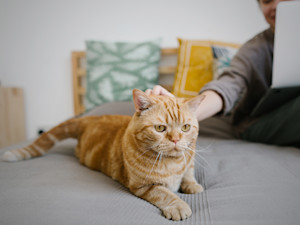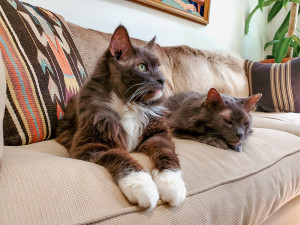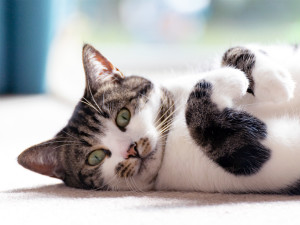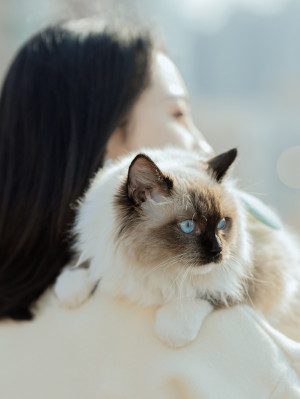How to Calculate Your Cat’s Real Age In Human Years
Whatever their real age, they’re still your baby

Share Article
Have you ever wondered how old your cat would be if they were human? You’re not alone. Of course pet parents want to know exactly what life stage their feline friends are at, so we can make sure they are provided with exactly what they need. The main framework we have for understanding ageing is our own, so it’s understandable that we want to relate our cat’s age back to human years, but they actually age completely differently to us.
How to calculate your cat’s age in human years
Figuring out how old your cat is in human years might seem a little bit complicated at first, and be warned, it isn’t an exact science. “There isn’t a definitive way of working out a cat’s age in human years, but we do have some reliable guidelines,” says Dr Rebecca MacMillan, a veterinary expert speaking on behalf of TrustedHousesittersopens in a new tab. “Cats do the vast majority of their growth, social development and sexual development during their first two years of life.

littleKin™ is Kinship’s home just for puppy and kitten parents. Bop over to check out expert advice, new pet tools, and special deals—all curated for your newest family member.
opens in a new tab“Sources suggest the first year of a cat’s life is equivalent to about 15 human years,opens in a new tab with the second year adding another nine years,” explains Dr MacMillan. “After that, each year is an additional four human years.”
While it isn’t exact, this rule of thumb provides a helpful guideline to figuring out roughly how old your feline friend is in human years. However, keep in mind there is a lot of nuance here, and it’s never going to be possible to make a direct comparison.
The first two years
The first two years see your cats age rapidly, and we mean rapidly. Imagine the rollercoaster of getting to age 15 in just one year. Whilst things slow down – slightly – in their second year, cats still age a further nine years. So at this point in their lives, cats have already rushed through life stages that take us human decades, and they are learning a lot as they go.
Pet expert Angela Laws – head of community at TrustedHousesitters – points out just how rapidly cats change during the first two years of their lives. “What’s fascinating is how quickly cats mature in those early years,” she explains. “The difference between a one-year-old and a two-year-old cat is remarkable – it’s like watching a teenager transform into a young adult in just twelve months.”
If you are trying to calculate the age of your brand-new kittenopens in a new tab, we can divide the 15 years they age in the first year by the 12 months in a year, meaning that on average they are ageing about 1 ¼ human years each month. This means at 12 weeks old; they are roughly just under four in human years – which might make you feel a little bit more understanding about why they keep trying to chewopens in a new tab through your laptop charger.
When your cat is in the second year of their life, they are ageing at roughly ¾ years each month – so you should add the number of months they are in their second year onto the 15 human years they aged in their first year of life. So, an 18-month-old cat is around 19 ½ in human years (easy, right?)
After two years
After their first two years, cats age more slowly and steadily, but remember they experience four human years for one of yours, so they still age faster than humans even at this stage.
If you are trying to calculate your cat’s age in human years and they’re over two years old, then you should count the first two cat years as 24 human years (15 for the first year, plus nine for the second), and then add four for each year they have been alive.
For example, if your cat has been alive for 12 years, it counts as 24 human years for the first two years, plus four years each for the ten years that follow, making them 64 in human years.
Cat ageing stages explained
Our feline friends go through six major life stages: kitten, junior, prime, mature, senior and geriatric. Devastatingly, they are kittens only six monthsopens in a new tab and they become juniors at month seven until they turn two.
Cats are in their prime in years 3–6, and then they graduate to mature at age seven. Three years later, your feline friend is officially a senior cat, and if they’re over fifteen then they’ve officially entered their geriatric years – and get to snooze uninterruptedopens in a new tab in the sun as much as they fancy.
Kitten (0–6 Months)
The window when they are kittens is pretty short – only six months – but remember they have roughly aged 8 ½ human years in this time. Dr MacMillan explains, “Cats are classed as kittens from birth to 6–7 months of age. During this time, they will do most of their growth and social development”.
Not only that, but “they will also go through puberty”, Dr MacMillan explains, so there is a lot packed into the first stage of their lives. This means they go through the equivalent human stages of infancy, toddler, childhood, and the start of adolescence all in six months.
Junior (7 Months–2 Years)
Cats become juniors around the time they enter the seventh month of their lives and this stage lasts until they are around two years old. “They are sexually mature at this point but will still be growing,” Dr Macmillan points out. Remember, they roughly age around nine human years in their second year, and by the end of this period they will be about 24 years old in human years.
Some larger breeds like Ragdolls and Maine Coons, may also keep physically growing beyond this, so if you’re the proud pet parent of one of these, start doing some weight training ahead of your visits to the vet.
Prime (3–6 Years)
From 3–6 years old, cats are officially classed as adults, going from about 24–36 in human years during this life stage. “They will have finished their growing and will be in the prime of their life,” says Dr MacMillan.
Mature (7–10 Years)
“At 7–10 years of age, they will be known as a mature cat,” says Dr MacMillan. “At this time, they will usually begin to calm down and become a bit more sedate.” This will be distinctly different from the high energy levels you are used to. This stage will see them go from their late thirties into their fifties in human years, so it’s no wonder they are settling down.
Senior (11–14 Years)
“Senior cats are considered to be 11–14 years of age,” explains Dr MacMillan, which will see them age from their late fifties into their early seventies in human years. Much like humans, now is the time to be alert to any changes in your cat because health issuesopens in a new tab may start to pop up, some of which can impact their mobility. “Many cats of this age will have a degree of osteoarthritisopens in a new tab and could be at risk of developing problems like hyperthyroidism or kidney disease, so regular vet checks are essential,” the expert notes.
Geriatric (15+ Years)
At 15 years old, cats enter their geriatric phase of their lives, which is the equivalent of being over 75 in human years. “This is considered to be a good age for a cat,” explains Dr MacMillan, “though some may live until they are 20 years old with the right health care and genetics.” Celebrating a 20th birthday would mean your cat is an incredible 96 years old in human years.
How long do cats live?
The heartbreaking reality is that the average lifespan of a cat is radically shorter than that of a human, so there will come a day when we are separated from our beloved feline friends, whose life expectancy ranges from 12–18 years in the UK.
Frequently asked questions
Do cats age faster than dogs?
Cats and dogs both age faster than humans, and dogs also age much faster at the start of their lives. However, because dog breeds vary in size so much, it’s complicated to compare cats and dogs – with larger dogs seeming to age more rapidly than smaller ones or cats. Dogs generally live on average between 10–13 years, which is a bit less than our feline friends, and are said to age five human years in one year – one more than cats.
Can a cat live over 20 years?
As Dr MacMillan noted, 15 is a great age for a catopens in a new tab to make it to, but there are some notable cats who have made it far beyond this point. Sadly, however, they are the exceptions to the rule. An adorable cat from Norwich called Rosie lived to be an incredible 33 years old – holding the Guinness World Record for the oldest cat in the worldopens in a new tab. She passed away in September 2024, at an amazing 152 human years.
What factors influence a cat’s lifespan?
Indoor cats are generally said to live longer than those who venture into the great outdoors, with indoor cats living between 12–18 years, and outdoor cats between 10–15. Dr MacMillan points out that cats who enjoy a healthy, nutrient rich diet, get lots of exercise, and regular vet visits can make a big difference, too.
How can I help my cat live longer?
“There are many things you can do to keep your cat fit and healthyopens in a new tab for as long as possible. These include having them on a good-quality diet that is appropriate for their age, to give them the optimum nutrition at each life stage,” says Dr MacMillan. “You should also ensure your cat doesn’t become overweight. Monitoring their food intake and body condition is one of the best things you can do to reduce the risks of joint disease, diabetes and canceropens in a new tab.
“Preventative health care is also really important, so ensure your cat is up to date with vaccinations and parasite treatments. Regular check-ups with the vet will also help spot and treat any developing health problems sooner which could potentially increase your cat’s life span.”

Emma Mackenzie
Emma Mackenzie is a freelance journalist based in London. When she isn’t working, she spends much of her time being informed that her two kittens can see a sliver of the bottom of their food bowl – the greatest offence they can imagine.
Related articles
![Young caucasian cheerful blonde girl sitting and hugging her lovely cocker spaniel dog in cafe.]() opens in a new tab
opens in a new tab10 Longevity Tips From People Whose Pets Have Lived Incredibly Long Lives
Follow these vet-backed tips to help your furry friend live a healthy and full life
![Two senior cats laying on a couch]() opens in a new tab
opens in a new tabWhy Senior Cats Make the Best Roommates
I adopted a couple of seniors because cats, like wine, only get better with age
![tri-colour, calico cat, white, black and tabby cat lying on their back with their paws lifted, looking at the camera]() opens in a new tab
opens in a new tab10 Common Cat Myths (That Are Actually False)
Peel back the layers of mystery to discover the truth about our feline friends
![Dark-haired woman holding her ragdoll cat]() opens in a new tab
opens in a new tab7 Purebred Cat Breeds Likely to Suffer from Genetic Disorders
And why this means adopting a cat from a rescue centre could be a better choice
